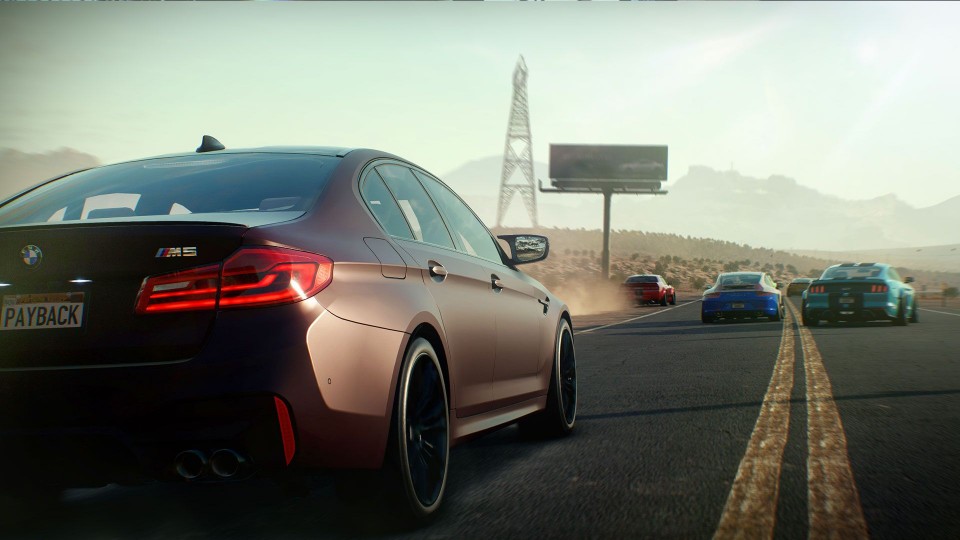After all the racing simulators this year, I’ve been missing the simpler times of arcade racers. The Burnouts, the Crazy Taxis, the MotorStorms, the WipeOuts, the Ridge Racers – even the Pod Racers. Their simple and bombastic nature is a retro contrast to the scientific approach many modern racers take. Nowadays, arcade racing is largely demoted to transport duty in open worlds.
Need for Speed is a relic in this regard. It takes something we do all the time in open worlds, and makes a whole game around it. That’s a little unfair to arcade racers considering they’ve been around longer, but that’s how the popularity of new genres and trends can refashion our attitudes of old ones.
I expected the hiatus to deliver significant overhauls (similar to that), only to find the same game Need for Speed took a break from being two years ago.
What you’ll find is the same groundwork of 2015’s reboot with an offline mode and microtransactions. The original game (that is 2015’s, not 1994’s), was always online and couldn’t be paused. While EA have done well to address that criticism, that’s a small issue compared to the new ones created.
Payback initially reminded me of Final Fantasy XV. The south-western setting and old-town gas stations could’ve fooled me into thinking the Regalia was finally free of its right-lane leash. Incidentally, they both have car upgrades. Payback’s approach to customisation however is approachable, a little weird, and rather egregious.

Customisation has been a hallmark of Need for Speed since Underground. Payback streamlines it down to an even simpler form. Upgrades work uniformly now via Speed Cards (yes that does sound suspiciously similar to Battlefront II’s Star Cards). They govern the six categories for tuning your car. They’re called cards because A) they’re shaped liked cards, and B) they’re randomised. You’re awarded one after a race, you can chuck in-game currency into a cheeky slot machine to earn them, or you can buy specific ones available at tuning shops. Payback is built like an RPG; levelling is a crucial part of progressing, and Speed Cards are the only way to do so.
Often times I’d struggle with an event, not because I was doing anything wrong – rather because my car didn’t have enough under the hood. Events in Payback don’t have level prerequisites, but they do recommend you reach a certain level. Usually my car in question was below the threshold. Other times I was equal to or well above the recommendation (one time by 70 levels), and the challenge was still disproportionate to my car.
The immediate solution – which the game actively suggests – is to grind. Play old races you’ve already done to get enough currency, so you can buy new Speed Cards and level up. This happened frequently during my playthrough. As you may have guessed, this is where Payback encourages buying loot boxes to avoid all this grind, which the game brings to your attention by providing some free ones.

While they don’t directly give you Speed Cards, the loot boxes do provide in-game currency, which you can in-turn use to purchase Speed Cards, and therefore level up faster. By way of being loot boxes, their contents are also random. So we have a system that awards you Speed Cards in several different ways; randomly after a race, randomly from a slot machine, and from the tuning shops that randomly rotate their stock. After all that, if you still need more cash for more Speed Cards (and cash is always short), you can buy more loot boxes… or you can grind.
What fantastic options.
Need for Speed games don’t usually get repetitive until the latter half. Payback starts that ball rolling from the start. Often times you can just buy a new car in these scenarios and the game feels new for a time, but Payback actually discourages this. Those Speed Cards I mentioned? You can’t simply unequip them from your old car and use them on your new one. Any card gained can only be used on the car you’re currently using. So not only did you probably just empty your virtual wallet buying that new car, but you’ve got to earn new Speed Cards to have any chance in a race, which again, you can achieve by grinding, or… yeah you get the point.
All of which is not only unfortunate, but overshadows the fact there’s a decent racing game underneath all this poppycock. The game is marvellous to behold (at least at night). There’s an enjoyable experience among the over-the-top drifting and racing. Just bear in mind you’ve got to really enjoy those two things, because the game doesn’t offer much beyond the main quest. The most interesting of which has you hunting the map for derelict cars and their corresponding parts, sort of like the treasure maps in Assassin’s Creed IV.

While open-world design can be complementary to racing games, Payback doesn’t use any creativity to achieve such. Not only is there a very large space with almost scant to do, but the races don’t make use of the freedom available. This isn’t like Burnout Paradise, where you’re given a destination and you plan or improvise your way there. Payback would rather see you through a series of checkpoints for what amounts to a linear race.
The game’s title summarises the story; there’s some betrayal, and you’re looking to do some paying back. There’s technically good dialogue, in the same way a Fast and Furious movie technically has good dialogue. Occasionally you’ll chuckle. The rest of the time you really won’t care.
There are other problems those too; restarting a race takes an off-putting amount of time, especially for the number of times you’ll have to do so. There’s also multiplayer, which is about as robust as a skeleton. You have two options: casual or ranked. Both are functionally the same. You go into a lobby, have a few races, earn some money and Speed Cards. That’s about it. If you want to spice things up you can try ranked matches, assuming you meet the level 275 criteria. If you’re playing a casual match, a low-level player can compete in the same race against someone levelled 300 plus. I didn’t say “compete fairly”, I just said they could compete.

As microtransactions become ever more common, I think it’s important we don’t let negative connotations get the better of us – because they’re not an inherently bad business choice. Not every game with microtransactions will make itself more grindy to encourage that $4 spend. Not every game will make them more attractive than actually playing the game. Not every game will perpetuate the very reason players complain about microtransactions.
But not every game will feel like Need for Speed: Payback.